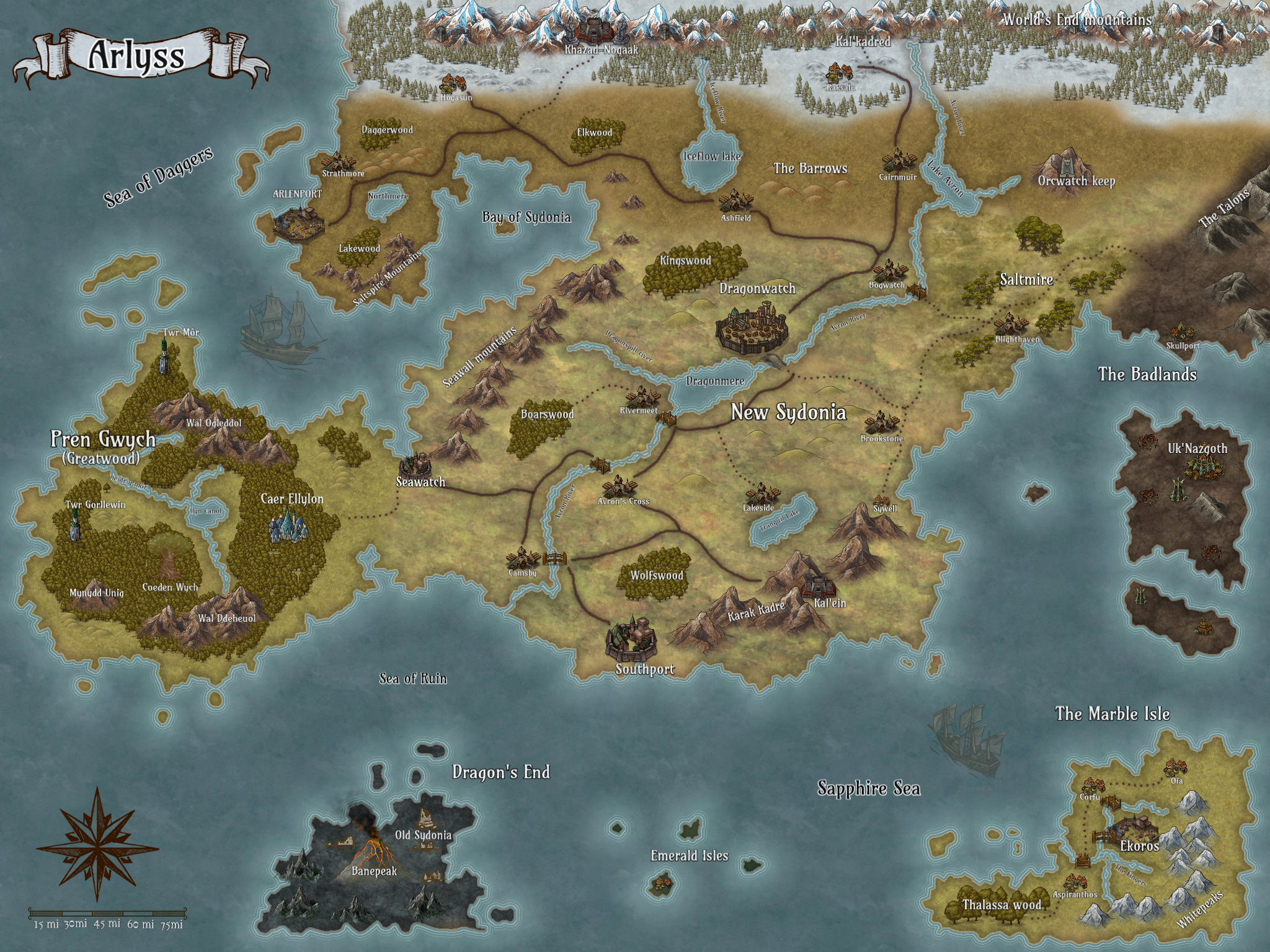A history of the world of Arlyss
Table of Contents
History of SydoniaHistory of Sydonia

Of the Dragons, The Wōdensammar and the coming of man
The history of Sydonia begins with dragons, or as the ancient Sydonians called them – Eoten. This is not to be confused with the modern usage of the word meaning “giants from the north.” The words “Dragon” and “Wyrm” would not be used until the Sydonian migration.
For millennia before the coming of man into Arlyss, the gods of the Wōdensammar battled the dragons of Dragon’s End. For Wōden, chief among them, had foreseen the coming of man and wished to make them a home.
On the island, there lived two dragon queens named Bahamut and Tiamat. The two sisters produced their own brood of dragons, each unique in their way. For the brood of Bahamut grew scales that shone in the hues of the metals of the earth and were more temperate. Meanwhile, the brood of Tiamat grew scales in the hues of red, green, blue, white, and black and were quick to anger. Bahamut herself shone in the radiance of precious metals like gold, silver, and platinum. Tiamat held a monstrous countenance with five heads, each of which represented the colors of her brood.
Chief among the gods of man was Wōden, the one-eyed god of magic and king of Nordheim. He fought alongside his sons Tiw (god of war and justice) and Baeldaeg (god of valor and champion of mankind). His wife Frig, goddess of prophecy, advised him. There were many other gods of the Wōdensammar, but these were the few who battled the dragons on Dragon’s End.
For a thousand years, the battle raged on across the island. Earth sundered, forests blazed, and lakes boiled in their wrath. Molten earth spewed forth from the depths of its tallest peak and covered the island in flame and death. Finally, the din of battle ended and Bahamut was first to see reason. She proposed a truce, which the gods accepted. Bahamut and her brood would remain hidden and not interfere with the coming of man. Tiamat refused and went into hiding in the caves and mountains of Dragon’s End. But Tiw chased her down and hunted her, and in the end captured her. For her treachery, she was tossed into the first layer of hell and imprisoned there. Tiamat cursed her sister’s betrayal and vowed revenge. Her hatred and malice bled into her brood and made them as they are now – malicious and possessed of an evil cunning.
Following their victory, the gods returned to their home in the branches of the world tree Eormensyl. All save Ing, goddess of harvests, who remained to make the island anew. She warned Bahamut not to despoil the land, for it was made for the coming of the children of Wōden.
Thus, did man awaken on the island of Dragon's End and find a bountiful paradise. Though the island gave them all they would need to survive, the gods did not make themselves present or guide the fledgling race. They learned to fear the dark places of the world and soon encountered the dragons of Tiamat’s brood. They named them “Eoten,” for no creature on Dragon’s End was larger. As Wōden’s children constructed villages and cities, the dragons despoiled and ruined them. Such despair ruled their lives that they thought their race would surely perish.
In those days, Bahamut liked to walk the island in the form of a crone. She watched the children of Wōden with immense curiosity and used her magic to hide her brood from them. But when it became apparent that the Wōdensammar would not interfere, she approached the tribes of man. She taught them many things, including the secrets of the earth and the art of forging. She would teach the first mage the art of weaving arcane energy into magic. His name was Sydonus, and he would rise to power through the art of magic.
As Bahamut departed, Sydonus proclaimed himself king and taught his art to a select few. The first council of mages would be made up of the distant ancestors of houses Godwyn, Ascania. and Dunkeld. Sydonus and his mages birthed the kingdom of Sydonia, and with their magic began to fight back against the dragons.
As the kingdom grew, the king began receiving visions in his dreams. Wōden and his pantheon presented themselves to him and revealed their hand in the making of their home. Wōden, as the god of magic, claimed the crone had been one of his agents sent on his behalf to grant him the holiest of secrets. Sydonus, seeking further power, revealed this to his people and proclaimed himself divinely chosen to rule. Thus, the church of Wōden was born, and practitioners of magic were elevated to divine station as holy men of the church.
As the Sydonians continued to develop their arcane art, other magic users began to appear. Those who did not learn the art, but received it naturally were thought heretical and put to the torch. A great inquisition was ordered by the third king of Sydonia, Alkebeth. To show natural magical ability was to court death, and the inquisition was ever watchful.
Nearly eight centuries passed, with the mageocracy of Sydonia conquering most of Dragon’s End. Yet, the Dragons continued to harangue the children of Wōden and mar their great works. Some fifty years before the event, a prophet named Ekoros warned of the coming doom of Sydonia. He gathered his faithful and fled the island, traveling east in three large ships. At the same time, Bahamut and her brood left the island forever. Ass great droves of metallic dragons were seen flying away, some regretted not heeding the prophet’s words.
With the metallic dragons gone, the brood of Tiamat were free to leave their caves and mountain lairs. Dragon attacks became more common, and Sydonians could scarcely keep them at bay. During the rule of King Agwellan (now known as Agwellan the Fool), the king petitioned the gods for aid. After nine years, his prayers were answered. But not by Wōden, but by Lopt—god of mischief and illusion. For Lopt had long ago been imprisoned in Hell. There, he met with Tiamat and the two found common ground in their shared hatred for Wōden and his kin. Lopt became her consort, and plotted long the demise of Wōden’s children.
In a dream, King Agwellan learned of a ritual that would destroy the dragons. When he awoke, he saw a raven perched upon his window sill and took it as an omen from Wōden (who kept a pair of ravens as messengers). He climbed the tallest peak on Dragon’s End (now known as Banepeak) along with nine of his mages. At the mouth of the volcano, he sacrificed the mages to the gods. As they leapt willingly into the abyss, he called upon Wōden and Tiw and Baeldaeg to smite the dragons once and for all. As he recited the incantation, the mountain split apart and sent a torrent of magma and burning ash across the island. The king was burned alive, but one of his servants (an ancestor of house Dunkeld) managed to flee and warn the Sydonians. As the island was once again transformed into a wasteland of fire and death, the survivors fled across the sea.
While the red dragons basked in their home remade, the rest of the dragons of Dragon’s End took to the skies and crossed the sea along with the Sydonians. In their Exodus, the Sydonians witnessed this migration with fear and trepidation, but the dragons paid them no heed. They fled to the mainland of Arlyss, where the environment would suit them best. And thus did the dragons become a plague upon the rest of the world.
Meanwhile, Dragon’s end became home to the red dragons and their kobold minions, who would plunder the ruins of Sydonia for treasures and often clash over the spoils. Deep in the ruins, the dragons discovered strange serpentine creatures possessing powerful magical ability. They surmised that the Sydonians, in their lust for power, had meddled with creation magic before their end.






